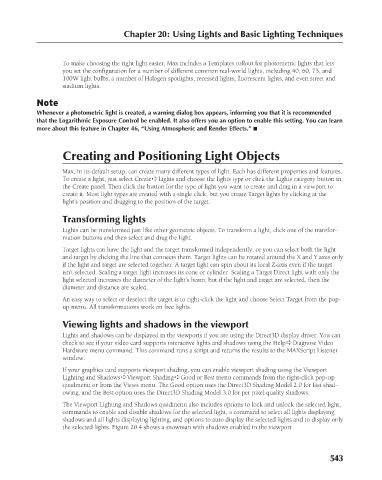Page 591 - Kitab3DsMax
P. 591
Chapter 20: Using Lights and Basic Lighting Techniques
To make choosing the right light easier, Max includes a Templates rollout for photometric lights that lets
you set the configuration for a number of different common real-world lights, including 40, 60, 75, and
100W light bulbs, a number of Halogen spotlights, recessed lights, fluorescent lights, and even street and
stadium lights.
Note
Whenever a photometric light is created, a warning dialog box appears, informing you that it is recommended
that the Logarithmic Exposure Control be enabled. It also offers you an option to enable this setting. You can learn
more about this feature in Chapter 46, “Using Atmospheric and Render Effects.” n
Creating and Positioning Light Objects
Max, in its default setup, can create many different types of light. Each has different properties and features.
To create a light, just select Create ➪ Lights and choose the lights type or click the Lights category button in
the Create panel. Then click the button for the type of light you want to create and drag in a viewport to
create it. Most light types are created with a single click, but you create Target lights by clicking at the
light’s position and dragging to the position of the target.
Transforming lights
Lights can be transformed just like other geometric objects. To transform a light, click one of the transfor-
mation buttons and then select and drag the light.
Target lights can have the light and the target transformed independently, or you can select both the light
and target by clicking the line that connects them. Target lights can be rotated around the X and Y axes only
if the light and target are selected together. A target light can spin about its local Z-axis even if the target
isn’t selected. Scaling a target light increases its cone or cylinder. Scaling a Target Direct light with only the
light selected increases the diameter of the light’s beam, but if the light and target are selected, then the
diameter and distance are scaled.
An easy way to select or deselect the target is to right-click the light and choose Select Target from the pop-
up menu. All transformations work on free lights.
Viewing lights and shadows in the viewport
Lights and shadows can be displayed in the viewports if you are using the Direct3D display driver. You can
check to see if your video card supports interactive lights and shadows using the Help ➪ Diagnose Video
Hardware menu command. This command runs a script and returns the results to the MAXScript Listener
window.
If your graphics card supports viewport shading, you can enable viewport shading using the Viewport
Lighting and Shadows ➪ Viewport Shading ➪ Good or Best menu commands from the right-click pop-up
quadmenu or from the Views menu. The Good option uses the Direct3D Shading Model 2.0 for fast shad-
owing, and the Best option uses the Direct3D Shading Model 3.0 for per pixel quality shadows.
The Viewport Lighting and Shadows quadmenu also includes options to lock and unlock the selected light,
commands to enable and disable shadows for the selected light, a command to select all lights displaying
shadows and all lights displaying lighting, and options to auto display the selected lights and to display only
the selected lights. Figure 20.4 shows a snowman with shadows enabled in the viewport.
543
6/30/10 4:26 PM
28_617779-ch20.indd 543
28_617779-ch20.indd 543 6/30/10 4:26 PM

